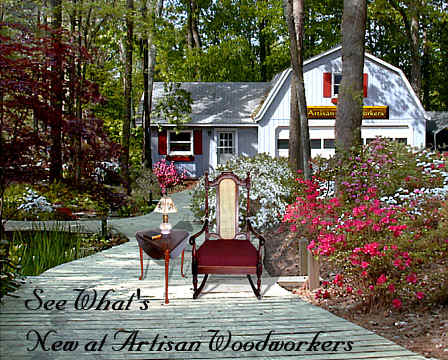

Glossary of Terms,
Antique Furniture
L
Lacquer: Oriental lacquer is aa high dense finish acquired by tedious padding up and rubbing down of many coats of sprits shellac. This has nothing to common with modern lacquer, which is a compound of cellulose derivatives. These dry so rapidly that they must be sprayed by compressed air. Such lacquers now posses many qualities not found in varnish or shellac finishes, such as the resistance to heat , moisture, and acids. It can be rubbed to a clear satiny finish that emphasizes the beauty of the wood; it is also made opaque, like paint, and tinted to any shade.
Ladder Back: Chair back with horizontal slants or rails resembling a ladder. Common types in Pilgrim furniture and in simpler Chippendale work.
Ladies' Desk: Lighter and smaller desks on legs, developed in France and England after 1690.
Lambrequin: Drapery hung from windows, shelves, or around the top of a bed; can also have a stiff backing.
Laminate: The binding up of layers; in wood panels three, five, or more layers are laid alternately across the grains for strength and durability.
Landscape Panel: Wood panel with the grain running horizontally.
Lathe: Machine for shaping turned parts by the application of cutting edges against the revolving wood.
Lap Table: Decorative rectangular board with deeply-curved cut-out on one side; used on lap or over chair arms for writing, eating, etc.
Lattice: Carved crisscross pattern in cutout work, found in chair backs, highboy pediments, etc.
Laureling: Decorative banding of laurel leaves, usually on a half-round molding.
Leaf: A table top extension. Also a decorative motif, used in both realistic and conventional forms.
Library Steps: A piece of occasional furniture, used to reach books on book shelves; steps variously combined with tables, stools, benches, etc., and often a hand rail.
Library Table: Large table with drawers and space for books, usually on a pedestal base.
Linenfold: Gothic ornamental panel treatment representing the folds of linen, probably after the folded napkin on the chalice in the Catholic ritual.
Lion Motif: Heads and paws of the lion used as decoration; heads often carved as knees of cabriole legs, paws as the feet. Also cast in brass for hardware such as the lion-and-ring handle.
Lip Molding: Small convex or quarter-round molding around drawers, originally intended as a dust stop in Queen Anne and Early Chippendale Casework.
Livery Cupboard: Early English food cupboard. Livery is probably a contraction of "delivery." Food was stored here and distributed to the household and to the poor. Ventilation was a necessity, often provided by grilled by grilles of wooden spindles, or tracery.
Loop-Back: Oval chair back; also Windsor bow back, without arms.
Lotus: The water lily conventionalized in classic ornamental form.
Lounge: Type of couch in late 19th Century work, often with one high end as a pillow.
Love Seat: Double chair or small sofa, Queen Anne and later. Also, "courting chair."
Low Relief: Shallow carved design.
Lowboy: English low chest or table with drawers. Beginning in Jacobean times by raising a chest on a stand, it continues through the English and American work of the 18th Century in various s forms as dressing tables, side tables, etc.
Lozenge: Decorative panel, overlay, motif, etc. in the shape of a diamond.
Lunette: Half-moon shaped decoration.
Lyre: Harp-type stringed instrument used as a decorative motif for chair backs, table pedestals, etc.; found especially on Duncan Phyfe furniture.
